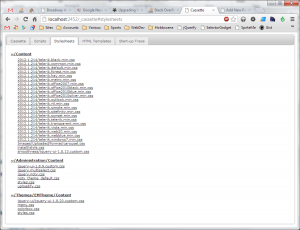Related to my recent post about cascading drop down lists, I needed to do some conditional validation based on a drop down list selection. I found a great post on Simon Ince’s blog about conditional validation in MVC 3. He even has a new project to wrap up some of the conditional functionality that he blogged about, but I decided to roll my own since I would learn more going that route.
Using the project attached to his post, I started dissecting what he was doing. After a while, I got the client validation working, but I realized I was so focused on the client/server validation piece that I did not get my conditions correct! After a few tweaks, I finally got everything working. Here is the custom attribute:
public class ConditionalMaximumWeightAttribute : ValidationAttribute,
IClientValidatable {
private const string ERRORMSG = "Weight must not exceed {0} lbs.";
public string DependentProperty { get; set; }
public string DependentValue { get; set; }
public int MaximumWeight { get; set; }
public ConditionalMaximumWeightAttribute(string dependentProperty,
string dependentValue,
int maximumWeight) {
this.DependentProperty = dependentProperty;
this.DependentValue = dependentValue;
this.MaximumWeight = maximumWeight;
}
public IEnumerable<ModelClientValidationRule> GetClientValidationRules(
ModelMetadata metadata, ControllerContext context) {
var rule = new ModelClientValidationRule() {
ErrorMessage = String.Format(ERRORMSG, this.MaximumWeight),
ValidationType = "maximumweight",
};
string depProp = BuildDependentPropertyId(metadata, context
as ViewContext);
rule.ValidationParameters.Add("dependentproperty", depProp);
rule.ValidationParameters.Add("dependentvalue", this.DependentValue);
rule.ValidationParameters.Add("weightvalue", this.MaximumWeight);
yield return rule;
}
protected override ValidationResult IsValid(object value,
ValidationContext validationContext) {
// get a reference to the property this validation depends upon
var containerType = validationContext.ObjectInstance.GetType();
var field = containerType.GetProperty(this.DependentProperty);
if (field != null) {
// get the value of the dependent property
var dependentvalue =
field.GetValue(validationContext.ObjectInstance, null);
var weight =
containerType.GetProperty(validationContext.DisplayName);
int weightvalue =
(int)weight.GetValue(validationContext.ObjectInstance, null);
// compare the value against the target value
if (dependentvalue == this.DependentValue &&
weightvalue > this.MaximumWeight) {
// validation failed - return an error
return new ValidationResult(String.Format(ERRORMSG,
this.MaximumWeight));
}
}
return ValidationResult.Success;
}
private string BuildDependentPropertyId(ModelMetadata metadata,
ViewContext viewContext) {
// build the ID of the property
string depProp = viewContext.ViewData.TemplateInfo
.GetFullHtmlFieldId(this.DependentProperty);
// unfortunately this will have the name of the current field appended
// to the beginning,
// because the TemplateInfo's context has had this fieldname appended
// to it. Instead, we
// want to get the context as though it was one level higher (i.e.
// outside the current property,
// which is the containing object (our Person), and hence the same
// level as the dependent property.
var thisField = metadata.PropertyName + "_";
if (depProp.StartsWith(thisField))
// strip it off again
depProp = depProp.Substring(thisField.Length);
return depProp;
}
}
Gist
To put this in context, I need to restrict a maximum weight allowed for a carrier. At a certain point, we may as well go with another carrier because it is cheaper. However, I don’t want to restrict the maximum weight if the carrier that has been selected is the cheaper carrier.
The attribute is used like so, where PropertyName is the name of the related property to check, PropertyValue is the conditional value of the property, and MaximumWeight is an integer representing the maximum weight for the conditional:
public class ...
[ConditionalMaximumWeight("PropertyName", "PropertyValue", MaximumWeight)]
[Required(ErrorMessage = "Weight required")]
public int? Weight { get; set; }
...
}
Here is the client-side implementation:
<script type="text/javascript">
$.validator.addMethod("maximumweight",
function (value, element, parameters) {
var carrier = $("#" + parameters["dependentproperty"]).val();
var carriervalue = parameters["dependentvalue"].toString();
var weightvalue = Number(parameters["weightvalue"]);
if (carrier == carriervalue && value > weightvalue) {
return false;
}
return true;
}
);
$.validator.unobtrusive.adapters.add(
"maximumweight",
["weightvalue", "dependentproperty", "dependentvalue"],
function (options) {
options.rules["maximumweight"] = {
weightvalue: options.params["weightvalue"],
dependentproperty: options.params["dependentproperty"],
dependentvalue: options.params["dependentvalue"]
};
options.messages["maximumweight"] = options.message;
});
</script>
Gist
I should probably do a little null checking in on the client-side, but I may just find that out the hard way! 🙂
